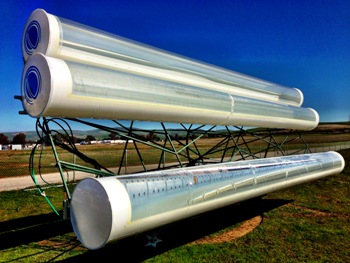May 15 2013
The California Energy Commission (CEC) has awarded $1.7 million to a partnership between Lawrence Livermore National Laboratory and Cool Earth Solar Inc. (CES) to conduct a community-scale renewable energy integration demonstration project at the Livermore Valley Open Campus.
 The concentrator photovoltaic (CPV) system in the field. Photo courtesy of Cool Earth Inc.
The concentrator photovoltaic (CPV) system in the field. Photo courtesy of Cool Earth Inc.
CES is the prime awardee and is contributing an additional $1 million in matching funds to the CEC amount, while LLNL will provide advanced R&D support for the effort.
This project will test and demonstrate a model for how communities can generate solar energy, forecasting that solar generation and developing energy management tools to adapt to that forecast. The net result will be a community that is able to reduce its total consumption and place more reliance on clean, locally available renewable resources.
LLNL will contribute advanced solar forecasting and building energy management for improved efficiency and peak load shaving while Cool Earth Solar Inc., also of Livermore, will provide concentrating photovoltaic (CPV) technology -- an innovative, low-cost, community-scale concentrated photovoltaic system.
By accurately forecasting the timing and amount of solar generation in a community setting, this project aims to demonstrate that more dense penetrations of photovoltaics (PV), on a community's distribution grid are possible.
The highly accurate and local forecasts developed under this award will link to building controls in the community so that the system can be adjusted to smooth fluctuations in demand and shave peak loads. Reducing peak loads would reduce the need to build and use more "peaker" plants -- fast start carbon-based generation plants used to stabilize the grid by providing additional generation quickly in high demand periods. This project will demonstrate on a micro scale a model that could be expanded and replicated.
Utilities are increasingly concerned by the effect solar intermittency has on load across the grid and its potential to unbalance power generation and demand and overload circuits. In some areas, distribution circuits experience large ramps due to high penetrations of PV and clouds quickly dissipating.
"This is an issue that can be addressed by better solar power forecasting to allow active balancing on the grid, including adaptive building energy management," said Wayne Miller, LLNL's lead on the project. "This project will develop and test the efficacy of this approach."
LLNL's role includes optimizing, testing and delivering a short-term (up to an hour ahead) solar power forecasting capability that will enable higher penetrations of solar by providing more predictable information on solar generation, allowing better management of the variable and intermittent solar power production.
"We are developing a dynamic cloud tracking system based on high-resolution sky imagers from CES and public domain satellite data," Miller said. "We can see the clouds as they come at you and can predict their dynamic effect on solar PV power."
Livermore also will develop and demonstrate improvements in building energy efficiency by using environmental and renewable energy forecasts to optimize HVAC controls. This will be tested at building 690 at Sandia National Laboratories, which has extensive HVAC SCADA infrastructure that can be used to implement and verify the technique.
In its role, CES will develop, test and deploy 100 kW of concentrated PV modules, which has distinct economic and environmental advantages over traditional flat panel PV solar. The Livermore Valley Open Campus (LVOC) community combines LLNL, Sandia National Laboratories (SNL), the city of Livermore, the iGate iHub and more than 33 community partners. As the primary renewable resource for the project, CPV is a good match for the community location. The campus also has open land that is available, free of shading obstacles and relatively flat. All of CES' technologies have been developed and tested in California and the work proposed in this project will be conducted in California.
In 2012, CES also signed an agreement with Sandia National Laboratories that could make solar energy more affordable and accessible. Sandia researchers will help pilot, characterize and validate CES' inflated, CPV technology. The company's equipment will be located on a five-acre site known as the Clean Energy Demonstration Field on the LVOC.